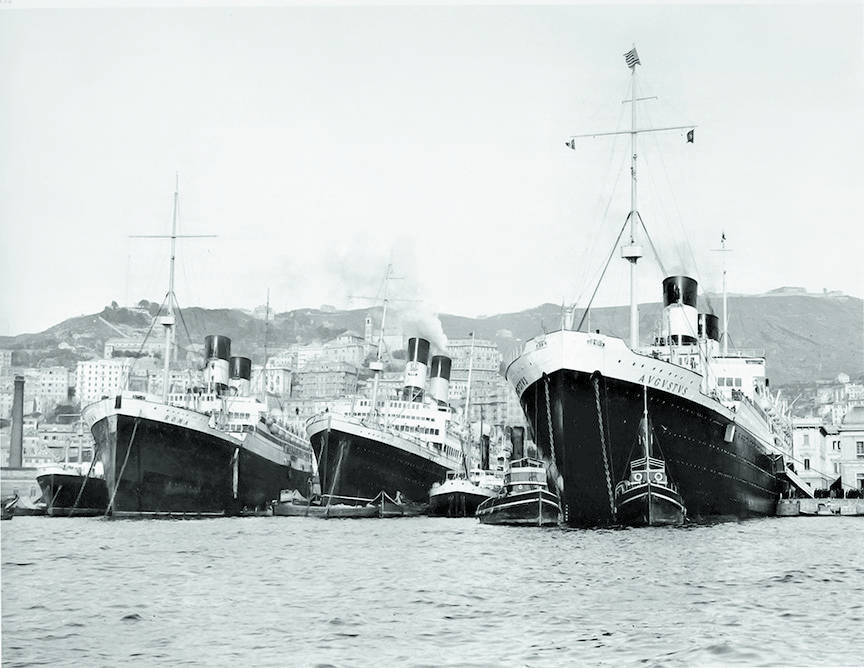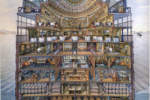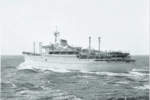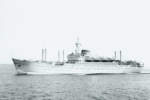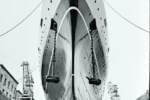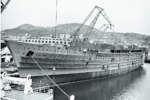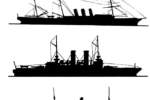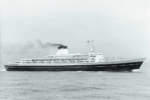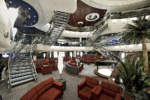The history of our large ships began on the eve of World War I, when the leading Italian navigation companies decided to launch a program aimed at building ships capable of crossing the Atlantic and that would, in terms of size and speed, surpass all the ships that had preceded them: the transatlantic liners. The outbreak of the war put a stop to the hectic activities; but nevertheless the twins “Duilio” (1916) and “Giulio Cesare” (1920) of Navigazione Generale Italiana – presented with the title “the Age of the Colossuses” in a brochure – and the twins “Conte Rosso” (1922) and “Conte Verde” (1923) of Lloyds Sabaudo – completed in spite of great difficulties after the war – turned out to be modern ships even if ten years had passed from their design to their actual construction. The two ships of the Sabaudo company, which vaunted unique interiors thanks to the furniture supplied by the Coppedè brothers of Florence, were inspired by the feats of Amadeus VI of Savoy, called the Red Count, and those of his son Amadeus VII, called the Green Count. Also the third Count, the “Biancamano” (1925), the first true Italian “floating city”, rendered homage to Umberto I, count of Moriana, called Biancamano due to the whiteness of his hands. To avoid losing time and money the fourth count, the “Conte Grande” (1928) had been built as a copy of the “Conte Biancamano”, thus completing the fleet of the “four Counts”. After the end of the war the “N.G.I.” launched its two new flagships of more than 30,000 tonnes, the “Roma” (1924) and the ’”Augustus” (1925), referred to as “Masterpieces” in the American brochure. Rendering another homage to ‘Romanity”, in 1924 N.G.I. ordered two new ships, baptizing them “Virgilio” (1925) and “Orazio” (1925); they became familiar to the Italian-American population of South America. Inspired by the modernizations introduced by N.G.I. and Lloyds Sabaudo, also Cosulich Line ordered the twin ships “Saturnia” (1927) and “Vulcania” (1928) from its shipyards in Monfalcone; both vaunted slender, original lines and very lavish interiors. In 1927 Mussolini announced the construction of “two ships the whole world was waiting for” and shortly afterwards the companies N.G.I. and Lloyds Sabaudo presented their new flagships: the “Rex” (1932) and the “Conte di Savoia” (1932), the former still built according to the old canons of the palace–ship, the latter an ambassador of modernity and the surpassing of traditional aesthetic canons. In 1932 Mussolini ordered the merger of the three leading navigation companies; the resulting passenger ship fleet was the largest that had ever sailed under the tricolour flag. In 1933 “Oceania” and “Neptunia”, the most beautiful ships on the Atlantic route of South America and the last to be built before World War II, were added to the 35 ships of the ‘Italia Flotte Riunite’ or united Italian fleets. In the years after the war, bombardments had deprived the prestigious pre–war fleet of more than half of its ships. Determined to rebuild it, our national company Società Italia di Navigazione, with headquarters in Piazza De Ferrari in Genoa, was soon to have what was once again defined as the world’s most beautiful fleet. The “Ansaldo” shipyards in Genoa and the “United Shipyards of the Adriatic” of Trieste and Monfalcone were ready to catch up and to relaunch the ships that had been sunk during the conflict. In 1947, before ordering the building of new transatlantic liners, the Italian company succeeded in recovering the four ships of above 20,000 tonnes which the American government had seized as booty of war: the “Conte Grande”, the “Conte Biancamano”, the “Saturnia” and the “Vulcania”. Risen again from the ashes, the four ships were transformed and modernized, once more becoming luxurious, comfortable and fast transatlantic liners plying the routes to South America and New York. The first new ship built after the war was the turbine steamship “Giulio Cesare” (1951), followed by its twin “Augustus” (1951); both were to serve the routes to South America. To meet a rapidly growing demand for passenger transport, the first real transatlantic liner, the “Ansaldo”, was launched in 1951 to ply the route to New York; it was soon to be followed by its twin, the “Cristoforo Colombo” (1954). Unfortunately, with the tragic sinking of the “Doria” in 1956, the Italian naval industry suffered a serious backlash, to which Italy sought to react with the construction of a new transatlantic liner in 1960, the “Leonardo da Vinci”. In the same year “Alitalia” opened its intercontinental service to New York with very modern DC–8’s, causing a progressive and rapid decrease of transport by sea. The last two ships launched by the Italian company were the “Raffaello” (1962) and the “Michelangelo” (1963); immediately afterwards the slipways of the “Ansaldo” and the “San Marco Shipyards” were demolished, and what used to be one of the most touching of sights was replaced by the hurried rite of launching in modern floating docks. The last Italian transatlantic liner, the “Eugenio C.” saw the light of day in Monfalcone in 1968; it was built by the Compagnia Costa Armatori Spa (1968–1986), formerly the “C” Giacomo Costa fu Andrea line (1947–1968) of Genoa. In 1970, the I.R.I. (“Institute for Industrial Reconstruction”), no longer knowing how to face the debts of the naval industry, decided to unrig the whole national passenger fleet. The first to be demolished was the “Giulio Cesare”, in 1973. With the economic slump and in a climate of austerity all the transatlantic liners were unrigged, one after the other: some were taken apart and demolished, others sold to foreign governments, and some were transformed into cruise ships for trips to the Caribbean or the Philippines. Only the “Guglielmo Marconi” remained in Italy; sold to Costa Armatori in 1986 as part of a program aimed at reviving tourism in the Mediterranean, it was renamed “Costa Riviera” and became the first ship of Costa Crociere Spa (1986–1990).
Already as of the Nineties orders for new ships grew rapidly; passenger transport by sea, that had seemed a thing of the past, became the latest fashion. To meet the extraordinary market demands Costa Crociere modernized and expanded its fleet: in 1986 the Fincantieri shipyard received the order for building the “Costa Classica”, which was launched in 1991, and in 1988 the Mariotti Shipyards of Genoa proceeded to turn the container ship “Axel Johnson” into the first ship of the Costa fleet belonging to a new generation, the “Costa Marina” (1990). In July of the following year Fincantieri received an order for the twin ship of the “Costa Classica”, the “Costa Romantica” (1993). In 1989 also the twin of “Costa Marina”, the “Costa Allegra” was born from the hull of the Annie Johnson; finally, in 1996 the “Costa Victoria” was launched. The new popularity enjoyed by cruises, as reproposed by Italian companies as Costa Crociere or foreign ones as the P&O, had relaunched the “invitation to travel” announced by Giò Ponti in the “Domus” magazine from 1929 to 1957. Thanks to the work of the architects Guido Canali, Pierluigi Cerri – in cooperation with Ivana Porfidi and the Swede Robert Tillberg – and Renzo Piano, the Nineties saw a reawakening of the interest in “ship design”. Betting on an outstanding design, combined with distributive rationality, modular installation and a decisive prevalence of hoteling functions over nautical ones, the two naval companies succeeded in staging a revival of a felicitous moment in the history of the design of ship interiors, the one that had, in the years after 1930, been recognized as the world’s best. The works of art installed on the Costa ships were perfectly integrated with the structure and the interior decoration; one of the artists present on board, Arnaldo Pomodoro, realized a large spherical sculpture in bronze for the Costa Classica. In 1990 Renzo Piano gave an unmistakable touch of class to the profile of the Crown Princes of P&O Cruises, designing the ship’s profile and superstructure with the particular design of the frontal “crown” of the panoramic upper deck, inspired by the profile of a dolphin. With the definitive takeover of Costa Crociere by the American “Carnival Corporation” group, in 1997, also the excellent design, the luxury and the works of art aboard the Costa ships have become only a memory. With the last generation of cruise ships, giants of more than 100,000 tonnes, the only large company which has resisted being incorporated by the great American groups, and which has maintained an all–Italian design, is the MSC (Mediterranean Shipping Company S.A., born in 1987 from the ashes of the Lauro Fleet) which, thanks to the work of Giuseppe De Jorio, still allows us to enjoy the style, good taste and elegance of Italian design in the interiors of the new cruise ships.
Caterina Frisone was born in Monza in 1961, the second of three children of an officer of the Andrea Doria. She graduated in architecture in 1986 from the Milan Polytechnic; in 1987 she completed a master in architecture in the United States. During her university studies she has collaborated with the Yankee Delta ship design firm and with the “Barche” magazine, designing sailing yachts and motor boats. In the meanwhile she has developed an interest in interior architecture, especially that of the Thirties and Fifties. After an apprenticeship in Switzerland she moved to Venice in 1991 to teach architectural planning at the IUAV and founding, in 2008, the Master of Architecture of the Ship and Yacht.


